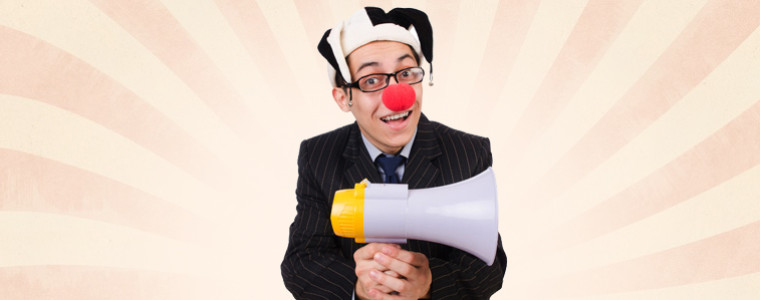3 rules about adding humor to your speech
My cousin Bobby, he can tell a joke. I envy him. Me, not so much. I can’t always remember the punch line. Which, you might not be surprised, is a joke-killer. So, in my presentations, I don’t start with a joke.
If you can tell a joke, however, it can be one of the best ways to begin your speech or, more accurately, a way to break the ice with your audience. But be warned: Joke-telling (like so many other techniques) is inherently risky. There are some basic rules by which you need to abide.
So Rule Number One: Tell your joke well and remember the punch line! (Seems obvious, but it needs to be said.)
Don’t make your audience the punchline
Rule Number Two is that your joke cannot be offensive in any manner whatsoever. I advise you strongly to run your joke by people to find out if it is – preferably people not on your payroll. Why? Because:
“Few people can see genius in someone who has offended them.” – Robertson Davies
What you think is offensive (or unoffensive) may or may not be perceived that way by someone else. And the worst way to begin a speech is to piss off your audience. Getting them back after that is virtually impossible.
Let me give you an example. About five years ago, I was coaching a Los Angeles City Councilperson who will remain nameless. It was a public speaking class and he was doing an impromptu speech about how great a new shopping center would be for the community in his district. As he was describing the benefits of the very upscale, very expensive shopping center, he decided to tell a joke … “and the best thing about this shopping center is the fabulous new Neiman Marcus. Why? Because all the women out there can go out and spend their husband’s money.”
Oh yeah! Can I get a rimshot? Puh-leeze.
It took a half an hour to convince Mr. City Councilperson that the joke was not only bad, but offensive. At first he felt that we were being too politically correct. Let me assure you: This isn’t about being politically correct; it is about meeting the needs of your audience and not offending them. That’s it.
Another time I was doing an in-house program at a mid-sized law firm in Northern California when this topic came up. In response, a senior partner raised his hand and asked, “But what if it’s a really funny joke and you only offend 10% of your audience?” He was serious and he got a great laugh out of the assembled participants, but I had an answer for him:
You don’t want to offend anyone in your audience, not even a fraction of those present, because as soon as you offend even a portion of your audience, they will begin to tune you out. Their body language shows it, and it becomes contagious. The people near them tend to notice as members of the audience disengage from a speaker and pretty soon the entire group has withdrawn their attention and approval. And why would you want to alienate even one person in your audience after spending so much time preparing a great presentation?
The risk is not worth the perceived reward. So don’t try it. If you tell a joke, make sure it’s not offensive.
Jokes that pack serious content
Here is the final rule with jokes: They work better during an introduction if the joke has some connection to your presentation topic or purpose. This means that your joke – in addition to being funny, being told well and not being offensive – needs some moral center, some relevance. It needs to be connected to the point of your presentation. Otherwise…it’s just a joke. And when there is a disconnect between the joke and the rest of your introduction and presentation, you have a real problem on your hands.
So if you’re going to be funny, be funny with a purpose.


